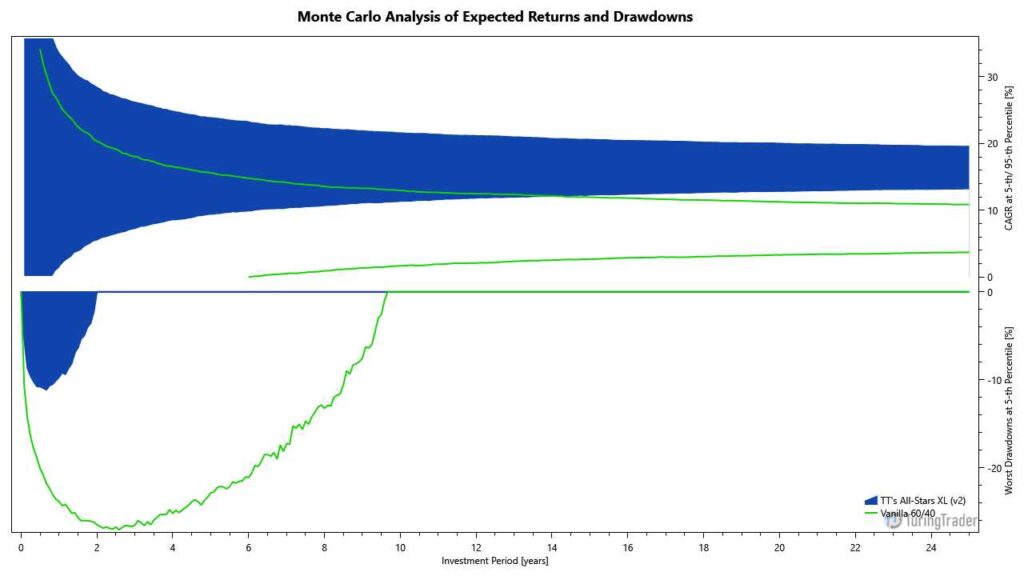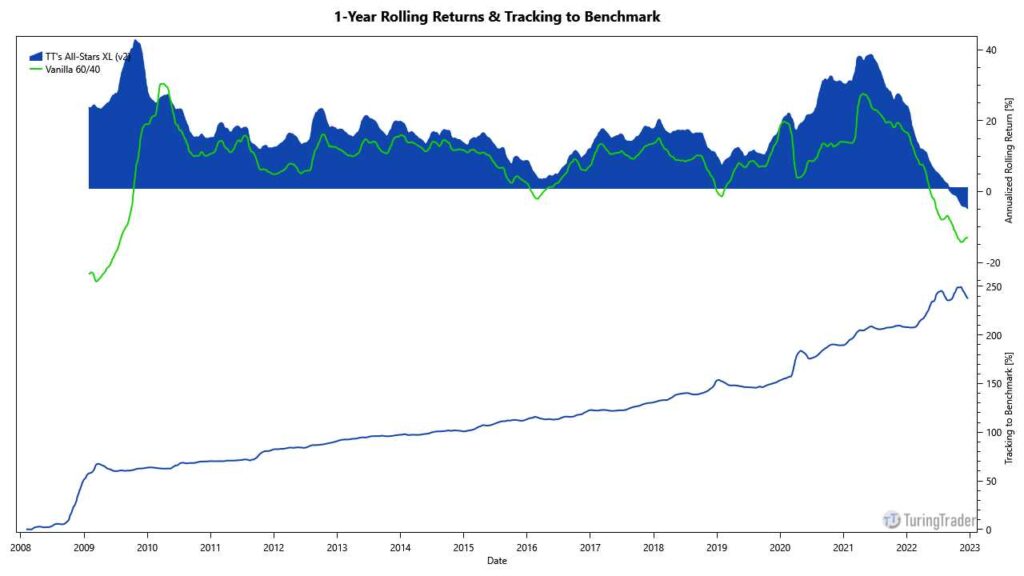Summary
- Objective: balanced growth
- Type: meta-portfolio
- Invests in: ETFs tracking stocks, bonds, commodities, hard assets
- Rebalancing schedule: monthly
- Taxation: 70% short-term capital gains
- Minimum account size: $25,000
Back to Basics is a meta-strategy combining three momentum strategies from well-regarded online publications. We introduced the strategy in October 2020.
Back to Basics aims to deliver improved risk/ return characteristics by diversifying across multiple sub-styles of momentum strategies. In addition to simple momentum, these styles include growth-trend timing, walk-forward optimization, and risk-management via a Canary Universe.
With its monthly rebalancing schedule, Back to Basics has low maintenance requirements.
Performance
This table shows the portfolio’s key performance metrics over the course of the simulation:
The following chart shows the portfolio’s historical performance and drawdowns, compared to their benchmark, throughout the simulation:
This chart shows the portfolio’s annual returns:
The following charts show the Monte-Carlo simulation of returns and drawdowns, the portfolios 12-months rolling returns, and how the portfolio is tracking to its benchmark:


Asset Allocation
The portfolio last required rebalancing after the exchanges closed on @last-rebal@. Due to fluctuations in asset prices, the exact allocations vary daily, even when no rebalancing occurred. The current asset allocation is as follows:
Sign up for our FREE Basic membership to see the asset allocation.
Sign up for our FREE 14-day trial to see the asset allocation.
Strategy Rules
The operation of Back to Basics can be summarized as follows:
- divide capital into three tranches
- allocate 50% to Universal Investment Strategy, and 25% each to Defensive Asset Allocation, and Lethargic Asset Allocation
- rebalance between the tranches once per month
Please refer to the component strategy’s pages for a more detailed description of the methodologies used by each component strategy.
Diversification
Back to Basics is broadly diversified across stocks and bonds from various markets and regions, as well as some commodities and hard assets.
Also, Back to Basics diversifies across multiple investment styles. Even though all four component strategies fall into the momentum category, they rely on different momentum flavors. By combining these, Back to Basics can reduce the portfolio’s concentration risk while improving the ability to cope with a broad range of market conditions.
Returns & Volatility
During bull markets, Back to Basics delivers returns that are about on par with the 60/40 benchmark. However, when contemplating the full economic cycle, the strategy beats its benchmark and the S&P 500 index. The strategy achieves these improvements thanks to its docile behavior during the 2008 and 2020 recession periods.
Overall, Back to Basics delivers decent returns at reduced volatility. The Monte-Carlo simulation confirms these claims of a solid upside and a much-reduced risk over the 60/40 benchmark.
Account & Tax Considerations
Back to Basics trades frequently and regularly triggers taxable events. However, two of the three tranches, the Universal Investment Strategy and the Lethargic Asset Allocation, often hold assets long enough to qualify for long-term treatment of capital gains. While the strategy works best in tax-deferred accounts, it still adds value to taxable accounts.
To allow for proper position sizing, Back to Basics requires a minimum investment of about $25,000.
